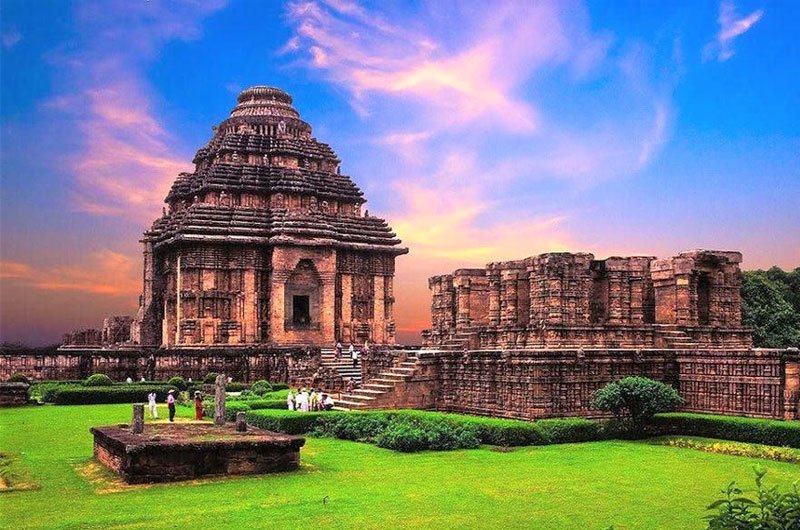
Konark Sun Temple: The Celestial Chariot of Odisha – A World Heritage Site
The Konark Sun Temple, located in Konark, Odisha, India, is a crowning achievement of Kalinga architecture and Hindu temple design. Dedicated to the Sun God Surya, this UNESCO World Heritage Site is renowned for its architectural grandeur, intricate sculptures, and astronomical significance. Built in the 13th century CE during the reign of King Narasimhadeva I of the Eastern Ganga dynasty, the temple is a masterpiece that continues to captivate visitors with its artistic finesse and spiritual allure.
Historical Background
- Eastern Ganga Dynasty
- Ruled over Kalinga (modern-day Odisha) and parts of Andhra Pradesh from the 11th to the 15th centuries CE.
- Known for their patronage of art, architecture, and cultural advancement.
- Temple Construction
- Constructed around 1250 CE under the supervision of King Narasimhadeva I and his chief architect Bisu Maharana.
- Designed as a colossal chariot with intricately carved wheels, horses, and mythical beasts symbolizing the Sun God’s celestial journey.
Architectural Marvel
- Design and Structure
- Built in the Kalinga style of architecture, emphasizing symmetry, geometric precision, and ornate sculptures.
- Features a main sanctum (garbhagriha), jagamohana (assembly hall), and natamandira (dancing hall).
- Outer walls adorned with elaborate stone carvings depicting celestial deities, mythological scenes, and daily life.
- Notable Features
- Kalinga Architecture: Known for its pyramidal shape, intricate carvings, and symbolic representations.
- Natya Mandapa: Hall for cultural performances and religious rituals, adorned with sculpted musicians, dancers, and celestial beings.
Specialty of Konark Sun Temple
- Astronomical Significance
- Oriented towards the east to align with the rising sun, symbolizing the Sun God’s daily journey across the sky.
- Sculptures and carvings designed to depict seasonal changes and celestial movements.
- Cultural Significance
- Represents the synthesis of religion, art, and science in ancient India.
- Symbolizes the Sun God’s importance in Hindu mythology and the worship of celestial deities.
Tourism Aspects
- Visitor Experience
- Guided tours available to explore the temple complex and understand its historical and architectural significance.
- Interpretive centers and exhibitions offering insights into Odisha’s cultural heritage and temple architecture.
- Light and sound shows depicting the temple’s history and mythological tales.
- Nearby Attractions
- Puri: A sacred pilgrimage city famous for the Jagannath Temple and annual Rath Yatra (chariot festival).
- Chandrabhaga Beach: Nearby coastal attraction known for its scenic beauty and religious significance.
- Konark Dance Festival: Annual festival showcasing classical dance performances against the backdrop of the Sun Temple.
- Events and Festivals
- Konark Dance Festival: Celebrates Odissi, Bharatanatyam, and other classical dance forms in honor of the Sun God.
- Magha Saptami: Annual ritual bathing of the Sun God’s image in the Chandrabhaga River, attracting pilgrims and devotees.
Impact on Locality
- Economic Significance
- Boosts tourism and local economy through visitor spending, hospitality services, and cultural events.
- Supports local artisans and craftsmen specializing in stone carving, sculpture, and traditional arts.
- Cultural Influence
- Enhances regional pride and historical awareness.
- Promotes preservation of traditional arts, crafts, and cultural heritage.
Preservation and Challenges
- Conservation Efforts
- Managed by the Archaeological Survey of India (ASI) and state authorities.
- Ongoing restoration and maintenance to preserve the temple’s architectural integrity and historical authenticity.
- Challenges
- Preservation against natural weathering, coastal erosion, and visitor impact.
- Balancing tourism development with conservation needs to ensure sustainable management of cultural heritage.
Conclusion
The Konark Sun Temple stands as a testament to Odisha’s rich cultural heritage and architectural prowess. As a UNESCO World Heritage Site, it attracts visitors from around the globe, offering a glimpse into India’s ancient temple architecture and the spiritual significance of the Sun God. The temple’s intricate sculptures, celestial alignment, and historical legacy continue to inspire awe and reverence, ensuring its place as a timeless symbol of artistic excellence and religious devotion in India’s cultural tapestry.
